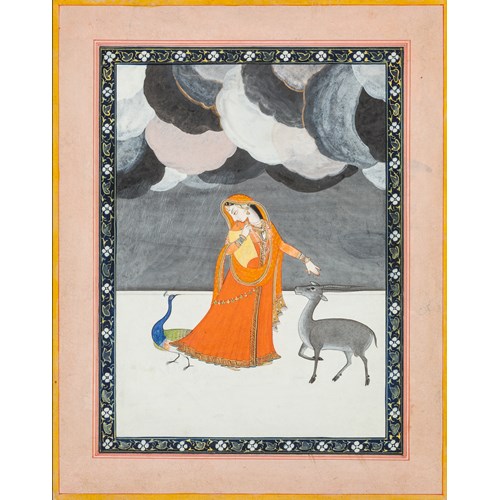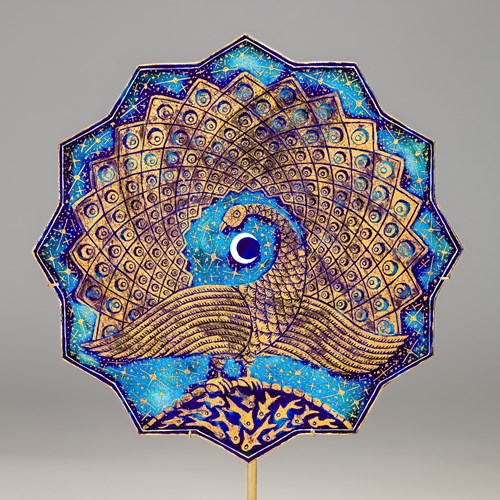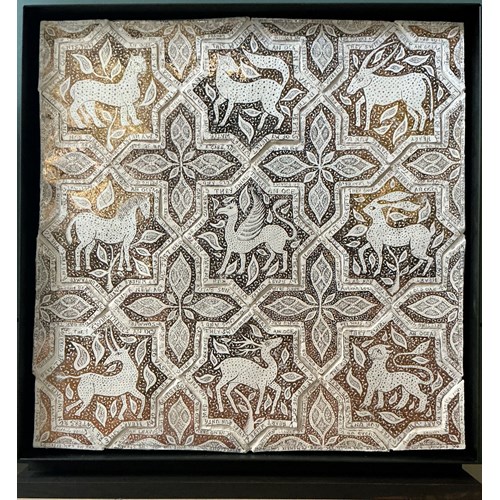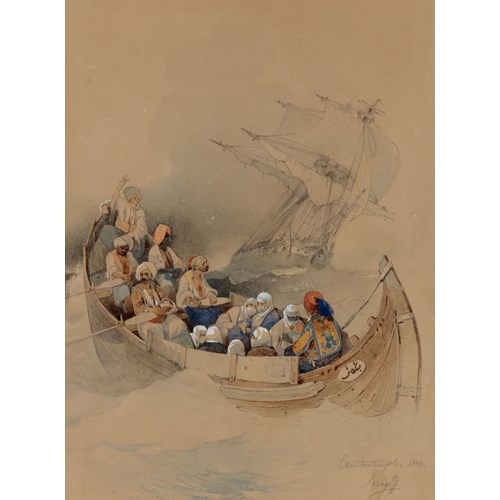Marketplace
A Blue & White Albarello Made for the Islamic market
A Blue & White Albarello Made for the Islamic market
Period Daoguang (1821-1850) Mark and of the period
Origin China
Medium porcelain
Dimension 29.5 cm (11⁵/₈ inches)
A jar in this shape is called an albarello, and its form derives from apothecary jars first used in the Middle East. Ultimately the shape probably goes back to an Egyptian precious metal form of the Roman period. Cylindrical jars were employed by physicians and herbalists and since they needed to be easy to hold, to use, and to shelve, their basic form was cylindrical but incurved for grasping and wide-mouthed for access.[1]
A revolution in Islamic pottery production occurred in the 10th century, when a new material called stonepaste was invented. This hard, white ceramic was composed of calcareous clays, quartz sand and powdered glass and it may have been developed by migrant Iraqi potters in Egypt. The ceramic was refined in the 11th century and its manufacture spread eastwards to Iran and to Syria in the late 11th century.[2] The new material was ideal for making and decorating vessels including albarello jars, which were made at many kilns. Extant examples include a mid-12th century albarello with carved decoration from Syria or Persia[3] and a late twelfth century jar with black painting under turquoise glaze from Kashan in Iran[4], both in the Victoria and Albert Museum. Another apothecary jar in the V&A, with panelled decoration painted in lustre and blue, dates to the late 12th or early 13th century.[5] In decorative terms, the distinctive Islamic qualities of the vessels’ surface patterning reflect the application of Islamic principles in artistic production, which in turn were the result of a long and complex process in which both political realities and religious ideals played an important part. As a whole, Islamic art was not exactly religious, as it was formed in a non-doctrinal context. Nor was it exactly secular, since it included the art produced for personal and communal devotions.[6]
Drug jars from Iran, Syria, and Egypt were introduced into Italy sometime before the 15th century, and lustre-decorated pots of Hispano-Moresque origin (influenced by the Moors in Spain) entered the country by way of Sicily. The shape therafter became popular throughout Europe, and vessels were made at many factories.
Cultural exchange between the Middle East and China goes back centuries. In the case of ceramics, Chinese fragments of porcelain alongside sherds of local pottery have been excavated in the ninth century, at sites in present-day Egypt and Iraq.[7] This magnificent Chinese porcelain albarello was made much later on, during the Daoguang reign period (1821-1850). As far as is known, its period is unique. The jar is a direct imitation of albarello jars first made at the Chinese imperial kiln in the early 15th century.[8] At that time, during the early Ming dynasty, Middle Eastern art objects were treasured by the emperor, and copies were made. Court taste was quite conservative, and in later times many shapes and patterns were meticulously reproduced, including albarellos like this piece which is painted in vivid cobalt blue with waves, lotus and honeycomb pattern.
[1] James Allan, Islamic Ceramics (Ashmolean Museum, Oxford, 1991), p.26.
[2] Robert Mason & Michael S.Tite, “The beginnings of Islamic stonepaste technology”, Archaeometry 36 (1) (Oxford, 1994), pp.77-91.
[3] Arthur Lane, Early Islamic Pottery (Faber and Faber, London, 1947), p.35, pl.47A. https://collections.vam.ac.uk/item/O85409/albarello-unknown/
[4] Rudolph E.A. Drey, Apothecary Jars (Faber and Faber, London, 1978), p.26, pl.10. https://collections.vam.ac.uk/item/O340299/albarello-unknown/
[5] Oliver Watson, Persian Lustre Ware (Faber and Faber, London, 1985), p.67, pl.29. https://collections.vam.ac.uk/item/O85414/albarello-jar-unknown/
[6] Tim Stanley, Temple and Mosque. The Jameel Gallery of Islamic Art at the Victoria and Albert Museum, (V&A Publications, London, 2004) p.37.
[7] Nasser D. Khalili, The Timeline History of Islamic Art and Architecture (Worth Press, Hertfordshire, 2005), p.90.
[8] A Chinese porcelain albarello dating to the Yongle period (1402-1424) in the imperial collections is illustrated in 故宫博物院藏文物珍品全集 青花釉里红1 (The Complete Catalogue of Treasures of the Palace Museum Blue and White Porcelain with Underglaze Red, volume 1) (Hong Kong, 2000), no.43 and can be seen https://www. dpm.org.cn/collection/ceramic/227626.html.
Stock no.: A5444
A revolution in Islamic pottery production occurred in the 10th century, when a new material called stonepaste was invented. This hard, white ceramic was composed of calcareous clays, quartz sand and powdered glass and it may have been developed by migrant Iraqi potters in Egypt. The ceramic was refined in the 11th century and its manufacture spread eastwards to Iran and to Syria in the late 11th century.[2] The new material was ideal for making and decorating vessels including albarello jars, which were made at many kilns. Extant examples include a mid-12th century albarello with carved decoration from Syria or Persia[3] and a late twelfth century jar with black painting under turquoise glaze from Kashan in Iran[4], both in the Victoria and Albert Museum. Another apothecary jar in the V&A, with panelled decoration painted in lustre and blue, dates to the late 12th or early 13th century.[5] In decorative terms, the distinctive Islamic qualities of the vessels’ surface patterning reflect the application of Islamic principles in artistic production, which in turn were the result of a long and complex process in which both political realities and religious ideals played an important part. As a whole, Islamic art was not exactly religious, as it was formed in a non-doctrinal context. Nor was it exactly secular, since it included the art produced for personal and communal devotions.[6]
Drug jars from Iran, Syria, and Egypt were introduced into Italy sometime before the 15th century, and lustre-decorated pots of Hispano-Moresque origin (influenced by the Moors in Spain) entered the country by way of Sicily. The shape therafter became popular throughout Europe, and vessels were made at many factories.
Cultural exchange between the Middle East and China goes back centuries. In the case of ceramics, Chinese fragments of porcelain alongside sherds of local pottery have been excavated in the ninth century, at sites in present-day Egypt and Iraq.[7] This magnificent Chinese porcelain albarello was made much later on, during the Daoguang reign period (1821-1850). As far as is known, its period is unique. The jar is a direct imitation of albarello jars first made at the Chinese imperial kiln in the early 15th century.[8] At that time, during the early Ming dynasty, Middle Eastern art objects were treasured by the emperor, and copies were made. Court taste was quite conservative, and in later times many shapes and patterns were meticulously reproduced, including albarellos like this piece which is painted in vivid cobalt blue with waves, lotus and honeycomb pattern.
[1] James Allan, Islamic Ceramics (Ashmolean Museum, Oxford, 1991), p.26.
[2] Robert Mason & Michael S.Tite, “The beginnings of Islamic stonepaste technology”, Archaeometry 36 (1) (Oxford, 1994), pp.77-91.
[3] Arthur Lane, Early Islamic Pottery (Faber and Faber, London, 1947), p.35, pl.47A. https://collections.vam.ac.uk/item/O85409/albarello-unknown/
[4] Rudolph E.A. Drey, Apothecary Jars (Faber and Faber, London, 1978), p.26, pl.10. https://collections.vam.ac.uk/item/O340299/albarello-unknown/
[5] Oliver Watson, Persian Lustre Ware (Faber and Faber, London, 1985), p.67, pl.29. https://collections.vam.ac.uk/item/O85414/albarello-jar-unknown/
[6] Tim Stanley, Temple and Mosque. The Jameel Gallery of Islamic Art at the Victoria and Albert Museum, (V&A Publications, London, 2004) p.37.
[7] Nasser D. Khalili, The Timeline History of Islamic Art and Architecture (Worth Press, Hertfordshire, 2005), p.90.
[8] A Chinese porcelain albarello dating to the Yongle period (1402-1424) in the imperial collections is illustrated in 故宫博物院藏文物珍品全集 青花釉里红1 (The Complete Catalogue of Treasures of the Palace Museum Blue and White Porcelain with Underglaze Red, volume 1) (Hong Kong, 2000), no.43 and can be seen https://www. dpm.org.cn/collection/ceramic/227626.html.
Stock no.: A5444
Period: Daoguang (1821-1850) Mark and of the period
Origin: China
Medium: porcelain
Dimension: 29.5 cm (11⁵/₈ inches)
Provenance: Scandinavian private collection. They lived in Hong Kong between 1904 to 1920, during which time this lot was acquired, thence by descent in the family.
More artworks from the Gallery









